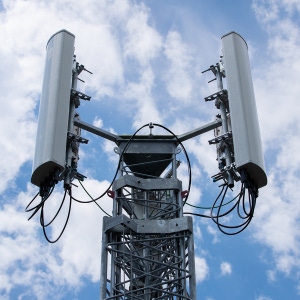Dish's 5G starts getting tangible
Joshua Broder, the CEO of tower construction company Tilson, recently tweeted a picture of a Dish 5G tower the company is building in Pennsylvania. He's not alone.

A number of cell tower companies around the country are starting to physically put Dish Network's 5G radios on top of their towers. The developments – although mostly anecdotal at this point – nonetheless signal a bit of a turning point for Dish from the 5G planning stage and into the deployment stage.
"It sounds like Dish is off to the races," reported the financial analysts with New Street Research based on comments from Jeff Stoops, CEO of cell tower giant SBA Communications. The analysts didn't provide any firm figures on SBA's financial expectations from Dish – Stoops mentioned Dish's activities as part of a wide-ranging discussion on the cell tower industry overall, according to the New Street analysts – but their conclusion was that "Dish is busier than SBA thought."
Stoops isn't alone.
American Tower CFO Rod Smith reported that the company is now seeing activity from Dish Network, which signed an agreement with the cell tower owner covering up to 20,000 towers in March. According to FierceWireless, Smith said American Tower isn't expecting any revenues from Dish until next year, but the work by Dish and others could portend a "record year" in terms of tower activity.
Similarly, tower giant Crown Castle is banking on "some" revenues from Dish this year, according to the financial analysts at Cowen.
The 5G mission
And Joshua Broder, the CEO of tower construction company Tilson, recently Tweeted a picture of a Dish 5G tower the company is building in Pennsylvania. "We are on a mission!" he said.
Collectively, the comments appear to indicate that Dish is in the early stages of embarking on its 5G buildout nationwide even as it works toward launching its first market, Las Vegas, in the third quarter of this year.
Due to Dish's 2019 agreement with the US Department of Justice, the company is to cover 20% of the US population by June 2022 with 5G, and 70% by June 2023.
In pursuit of that goal, Dish in November 2020 activated its first 5G cell site in Littleton, Colorado, where the company's wireless networking business is based. In the subsequent months it inked tower agreements with companies ranging from American Tower to Crown Castle to UScellular, Vertical Bridge and others.
Now it appears the company is beginning to work with those tower companies to physically install its 5G radios atop those towers. That work is likely being done mainly by the tower companies themselves or by third parties, but Dish has also been hiring its own tower technicians. Indeed, the Wireless Infrastructure Association – the main trade group for US tower companies – last year profiled one of Dish's tower climbers, Martha Ramos.
"When I first started this venture, I really didn't know what I was getting myself into, but I knew this was the way Dish was going. This was the future and I wanted to move with the company," Ramos told WIA.
The open RAN difference
Interestingly, according to the financial analysts at Cowen, Dish's 5G towers are a little bit different from those of other operators. The analysts, citing comments from Crown Castle CFO Dan Schlange, reported that they expect Dish "to deploy less equipment at the base of the tower with its 'hub and spoke' O-RAN network architecture."
They continued: "Although [Crown Castle] management expects additional equipment to be placed at the top of the tower which generates the 'vast majority' of tower revenue and will partially offset this, as we've previously noted we believe Dish's average new lease pricing of ~$1,500/month reflects in part the lower revenue from its O-RAN architecture," the analysts wrote.
Dish, for its part, has promised an open RAN 5G network that relies on 5G radios supplied by Fujitsu and MTI that are controlled by software run inside the public Amazon cloud.
That's different from traditional wireless networks in the US, which typically rely on radios from big vendors like Nokia and Ericsson controlled in part by basestations from those vendors located at the base of cell towers.
Related posts:
— Mike Dano, Editorial Director, 5G & Mobile Strategies, Light Reading | @mikeddano
About the Author(s)
You May Also Like




_International_Software_Products.jpeg?width=300&auto=webp&quality=80&disable=upscale)







